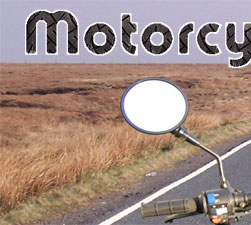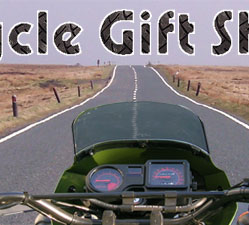|

|
The first thing a person should do BEFORE getting on a motorcycle is familiarize themselves with the bike's controls. Many of the functions will be the same as one would find on a car but their form might be a little different from what automobile drivers are used to. Cars are cluttered up with a lot of bells and whistles from climate control to radio knobs. Motorcycles are no-nonsense. Basically, every switch, button or lever is essential to safe operation and everything has to be in close proximity to a rider's fingers and toes. A motorcycle rider must be able to work any given control at a split second's notice without hesitation or having to look around to find it. The exact layout of the motorbike's controls can vary among models or manufacturers so it is important to familiarize yourself with the vehicle you will be operating before getting on that seat.
Primary Controls
The motorcycle's primary controls are used through the ride to accelerate and decelerate the vehicle. They include the throttle, clutch, gearshift and both brakes. From a rider's perspective, the right hand will control the throttle and front brake; the right foot controls the rear brake; the left hand operates the clutch and the left foot is used to shift gears. All these controls will be operated together to make your ride smooth and safe.
- Throttle: A motorcycle's throttle is the right
handgrip and it is the equivalent of the gas pedal on
a car. Rolling the throttle toward you increases the motorcycle's
engine speed and rolling the throttle away from you will
obviously decrease its speed. If released, the handgrip
should return to the idle position. The MSF course will
teach you to keep your wrist positioned low on the throttle.
This can help prevent accidental or excessive acceleration.
- Clutch: A motorcycle's clutch is a lever located
in front of the left handgrip. Squeezing the lever will
disengage the clutch and remove all engine power from
the rear wheel. Slowly easing out this lever will connect
power from the engine to the drive train again.
- Gear Shift Lever: This lever is found in front
of the left foot peg on the motorcycle. The gearshift
in most standard transmission cars follows an H-pattern
with the center of the H always being neutral. Most motorcycles
rely on a ratchet shift device (suicide shifters are an
exception). Neutral is actually in between first gear
and second gear (a half shift up from 1st gear or a half
shift down from 2nd gear). The standard gear pattern is
1 - N - 2 - 3 - 4 - 5. To shift up one gear, the motorcycle
rider will lift the lever with his toe. To shift down
one gear, the rider will press down. Because of the ratcheting
mechanism it is only possible to shift one gear at a time
before returning to center. When the lever is allowed
to return to its natural position, it resets and is ready
to shift up or down again. Finding neutral can be tricky
for first time riders until their left toe develops the
feeling and control to accurately make a half shift. Often,
a light on the control panel will indicate when the motorcycle's
transmission is in neutral.
- Front Brake Lever: The front brake lever is
located in front of the motorcycle's right handgrip. It
is engaged by squeezing the lever smoothly and progressively
(with increasing firmness). Abruptly grabbing of the motorcycle's
front brake can result in a front tire skid. If the front
tire skids, release the brake immediately and reapply
smoothly.
- Rear Brake Pedal: The rear brake pedal is located
in front of the right footrest. Pressing down on the pedal
engages the brake. This also should be applied smoothly
and progressively. Abruptly engaging the motorcycle's
rear brake can induce a rear tire skid. If the rear tire
skids, DO NOT release the brake but keep firm pressure
until the motorcycle stops moving. Releasing the brake
during a rear wheel skid can result in a high-side crash,
which has been known to throw riders off their vehicles.
Secondary Controls
The secondary controls are focused less on controlling the motorcycle but are important nevertheless. Again, there are variations on the look and location of these controls among different models of motorcycles but most bikes will have them.
- Electric Starter: Most modern motorcycles have
electric starters (instead of kick starters). It is a
simple button that is located on the right handgrip that
you push and hold until the engine turns over. Make sure
that the fuel valve is in the ON or RES position, the
ignition switch is ON and the engine cutoff switch is
set to run before attempting to start. Do not hold the
start switch for more than five seconds at a time or the
starter motor could overheat. Wait fifteen seconds before
using the starter again. In cold conditions, using the
choke to help start the motorcycle will usually make it
turn over easier. Usually, the motorcycle will have to
be in neutral or have the clutch lever in to start. Often
a switch in the side stand will not allow the motorcycle
to be started if the transmission is in gear and the stand
is down.
- Engine Cut-Off Switch: This is a switch located
next to the right handgrip, near the starter button. The
switch, operated with the thumb of the right hand, will
immediately shut off the motorcycle's engine. Many have
the RUN position in the center and throwing the switch
either way will kill the engine. This is designed to give
the rider the ability to stop the engine without removing
either hand from the handlebar.
- Speedometer: A motorcycle's speedometer functions
pretty much the same as a car's and is designed to show
the road speed.
- Tachometer: A motorcycle's tachometer indicates
the engine's speed in RPM (Revolutions Per Minute). It
helps the motorcycle rider know when to shift gears. The
tachometer will have a red line that is not to be exceeded
without risking damage to the engine.
- Temperature Gauge: Most, though not all, motorcycles
will have a temperature gauge. Once the engine has reached
its operating temperature, it should remain fairly stable.
If the motorcycle is running very hot, it may be an indication
of cooling system problems. If an engine overheats, it
can damage and warp internal parts.
- Odometer: The odometer keeps track of the miles
a motorcycle has traveled. The main odometer monitors
the lifetime miles of the motorbike. The trip odometer
can be reset and is designed for short-term use (usually
only tracks up to 999 miles before rolling over to zero).
The trip odometer can be used to monitor the number of
miles between filling the gas tank so the rider can anticipate
fuel needs without being forced to run on the reserve
tank.
- Turn Signal Switch: On most motorcycles, the
rider must manually cancel the turn signal (since there
is no steering wheel to identify once the turn is complete).
This control is near the left handgrip operated with the
left thumb.
- High/Low Beam Switch: Normally, motorcycle
headlights will run whenever the motorcycle is on. This
helps to improve visibility in any conditions. The rider
can change from low beam to high beam with this switch,
located near the left handgrip.
- Horn: The motorcycle's horn is also located
near the left handgrip and is used to alert other vehicles
of your presence.
- Fuel Supply Valve: Most motorcycles have a
valve between the gas tank and the carburetor. It usually
will have three positions. The ON position is selected
while riding the motorcycle under normal conditions. The
OFF position is used if the bike will be unattended for
a length of time. The RES position switches from the normal
gas tank to the reserve portion of the tank. The gas tank
reserve is designed to save enough fuel for the rider
make it to a refueling station. This is important because
many motorcycles do not have fuel gauges.
- Choke: Located either near the left handgrip
or near the engine, the choke feeds additional fuel to
the carburetor to make it easier to start the motorcycle,
especially in cold conditions. Once the engine has warmed
up, it is important to remember to turn off the choke.
Running with the choke open unnecessarily can cause the
engine to run rich or prematurely wear engine components.
- Ignition Switch: The motorcycle ignition switch
is usually located near the instrument panel. The keyed
switch will often have three or four positions. These
include ON, OFF, LOCK and sometimes PARK. The ON position
should be selected while riding (and will immediately
turn on the headlight). The OFF position disables the
engine and lights but the front forks of the motorcycle
will still move freely. If the motorcycle is to be left
unattended, the front forks should be turned all the way
to the left and either the LOCK or PARK position selected.
Both LOCK and PARK will prevent the straightening of the
handlebars so a passerby cannot just walk off with your
bike. The PARK position locks the handlebars and lights
the rear taillight for better visibility at night. Care
should be used when selecting the PARK position since
it can wear the battery down. Some motorcycles (but certainly
the minority) also have an accessory position but it should
be used judiciously as well for the same reason.
|






